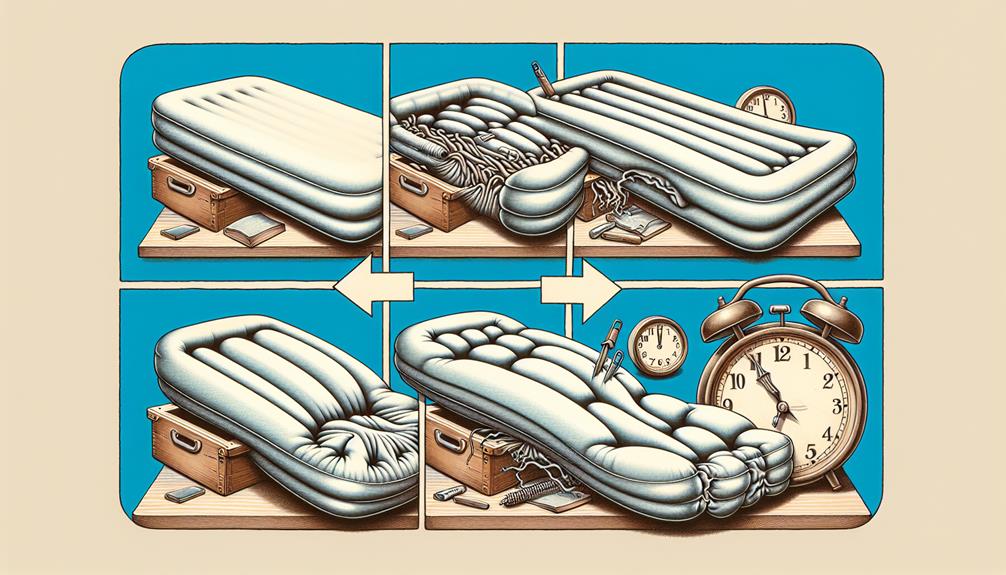Air mattresses have become a popular choice for temporary bedding, offering convenience and versatility. However, a common concern among users is the potential loss of air over time.
The issue of air mattress deflation can be attributed to various factors that affect its stability and firmness. Understanding these factors is crucial for ensuring a comfortable and uninterrupted sleep experience.
By exploring the causes behind air mattress deflation, one can better equip themselves with the knowledge needed to address this common issue and prolong the lifespan of their inflatable bedding.
Key Takeaways
- Air mattresses naturally lose air due to material permeability.
- Temperature fluctuations impact air pressure inside the mattress.
- Weight distribution and frequent usage can accelerate air loss.
- Proper storage practices can help maintain air mattress firmness.
Common Causes of Air Mattress Deflation
The gradual deflation of air mattresses is commonly attributed to inherent material permeability, which allows air to slowly escape over time. Material quality and durability play key roles in determining the rate at which this deflation occurs. Higher quality materials with better durability are less prone to developing leaks or permeability issues, thus maintaining inflation for longer periods.
External factors such as sharp objects, rough surfaces, or even pet claws can puncture the mattress, leading to leaks and subsequent air loss. Regular wear and tear can also impact the overall integrity of the material, making it more susceptible to leakage.
To mitigate these issues, it is essential to invest in air mattresses made from high-quality, durable materials and to place them on smooth surfaces free of potential puncture hazards. Additionally, promptly addressing any leaks with patch kits or sealants can help prolong the lifespan of the air mattress and reduce the frequency of air loss.
Impact of Temperature Changes
Given the susceptibility of air mattresses to gradual deflation due to factors such as material permeability and physical damage, it is imperative to explore the impact of temperature changes on the inflation stability of these portable bedding solutions. Temperature fluctuations can significantly affect the air pressure inside an air mattress. As temperatures change, the air molecules inside the mattress either expand or contract, leading to fluctuations in air pressure. This phenomenon is particularly noticeable in air mattresses due to their inflatable nature. The material composition of the air mattress plays a crucial role in how it responds to temperature changes. Materials with higher thermal conductivity tend to be more responsive to temperature fluctuations, resulting in more significant changes in air pressure. Conversely, materials with lower thermal conductivity provide better insulation against temperature variations, thus aiding in maintaining a more stable air pressure. The table below summarizes the impact of temperature changes on air mattresses:
| Temperature Changes Impact | Description |
|---|---|
| Air Pressure Increase | Hot temperatures can lead to air pressure increase inside the mattress. |
| Air Pressure Decrease | Cold temperatures can cause air pressure to decrease within the mattress. |
| Material Composition | Materials with higher thermal conductivity are more responsive to temperature changes. |
| Insulation | Materials with lower thermal conductivity offer better insulation against temperature fluctuations. |
| Inflation Stability | Temperature changes can affect the overall inflation stability of the air mattress. |
Effect of Weight and Usage
Analyzing the impact of weight and usage on air mattresses reveals crucial insights into their durability and performance over time. Weight distribution plays a significant role in how well an air mattress maintains its firmness and shape. Excessive weight concentrated on specific areas can lead to uneven pressure distribution, causing the mattress to lose air more rapidly in those spots. This uneven stress on the material can also increase the likelihood of punctures or leaks, affecting the long-term durability of the mattress.
Furthermore, frequent or prolonged usage of an air mattress can accelerate wear and tear, potentially leading to air loss over time. Continuous folding and unfolding, as well as frequent inflation and deflation cycles, can put strain on the seams and valves of the mattress, compromising its overall integrity. To maintain optimal performance and longevity, it is essential to consider weight distribution and usage habits when using an air mattress, as these factors directly impact its long-term durability and effectiveness.
Importance of Proper Storage
Proper storage practices are essential for maintaining the longevity and performance of air mattresses, complementing the considerations of weight and usage to ensure optimal durability. When it comes to proper maintenance and storage techniques for air mattresses, attention to detail is crucial.
- Cleanliness: Before storing the air mattress, ensure it is clean and free from any debris or moisture. Dirt and moisture can lead to mold or mildew growth, affecting the mattress's integrity.
- Dry Environment: Store the air mattress in a dry environment to prevent any moisture buildup, which can damage the material and cause odors over time.
- Avoid Sharp Objects: When storing the air mattress, make sure it is away from any sharp objects that could puncture or tear the material, leading to air leaks.
- Proper Folding: When folding the air mattress for storage, follow the manufacturer's guidelines to prevent creases or damage to the seams, which can impact its performance.
Tips for Maintaining Air Mattress Firmness
To maintain optimal firmness in an air mattress, regular monitoring and adjustment of air pressure levels are essential. Pressure points play a crucial role in determining the overall comfort and support provided by the mattress. It is recommended to periodically check the air pressure using a pressure gauge and make necessary adjustments to ensure that the mattress remains firm and supportive.
When it comes to inflation methods, following the manufacturer's guidelines is key to maintaining the desired firmness of the air mattress. Overinflation can lead to increased pressure on specific areas of the mattress, causing discomfort and affecting sleep quality. On the other hand, underinflation can result in a lack of support and potential sagging.
Additionally, avoiding sharp objects and rough surfaces can help prevent punctures and leaks that may compromise the firmness of the air mattress. By implementing these tips and staying vigilant about pressure levels, users can enjoy a comfortable and supportive sleeping surface for an extended period.
Frequently Asked Questions
Can Air Mattresses Lose Air Faster in Certain Types of Climates or Environments?
Climate impact can vary the rate of air loss in air mattresses due to factors like temperature fluctuations and humidity levels. Different environments can affect the durability of air mattresses, influencing inflation maintenance.
Humid climates may accelerate air loss through material expansion and contraction processes. Proper care and maintenance, such as regular inflation checks and storage in controlled environments, can help mitigate these issues.
Selecting air mattresses designed for specific climates can also enhance longevity.
Are There Certain Types of Air Mattresses That Are More Prone to Losing Air Over Time?
When considering air mattress materials and durability, it is vital to note that certain types of air mattresses may be more prone to losing air over time compared to others. Factors such as the quality of materials used, seam construction, and overall design can contribute to air retention capabilities.
Additionally, the effectiveness of inflation methods, like built-in pumps versus manual inflation, can also impact the long-term stability of air mattresses.
How Often Should Air Mattresses Be Checked for Leaks or Deflation?
Regular maintenance of air mattresses is crucial to prevent leaks and ensure optimal performance. To maintain inflation levels, it is recommended to check for leaks or deflation every few weeks. This frequency may vary based on usage and environmental factors.
Utilizing repair techniques such as patch kits can help address any leaks promptly. Following manufacturer guidelines for maintenance and leak prevention can extend the lifespan of the air mattress.
Can Using an Air Mattress on a Regular Basis Lead to Quicker Deflation?
Regular use of an air mattress can impact its durability and inflation rate. Increased pressure and frequent folding or bending can lead to quicker deflation over time.
Factors such as the quality of materials, maintenance routine, and overall wear and tear also play a role in the longevity of the air mattress. To maintain optimal performance, it's advisable to follow manufacturer guidelines and periodically inspect for leaks or signs of deflation.
Are There Specific Maintenance Routines That Can Help Prevent Air Mattresses From Losing Air Over Time?
Regular maintenance practices play a crucial role in prolonging the lifespan of air mattresses and preventing air loss over time. Implementing preventive techniques such as checking for leaks, tightening valves, and storing the mattress properly can help maintain optimal air pressure.
Consistent inspection and timely repairs can address potential issues before they escalate, ensuring the longevity and performance of the air mattress.
Conclusion
In conclusion, the gradual deflation of air mattresses can be attributed to various factors such as temperature changes, weight, and usage, and improper storage.
To maintain optimal firmness, it is important to address these factors and follow proper maintenance tips.
Just as air mattresses require diligent care to prevent deflation, so too do we need to attend to the subtle changes in our lives to maintain stability and resilience in the face of challenges.

